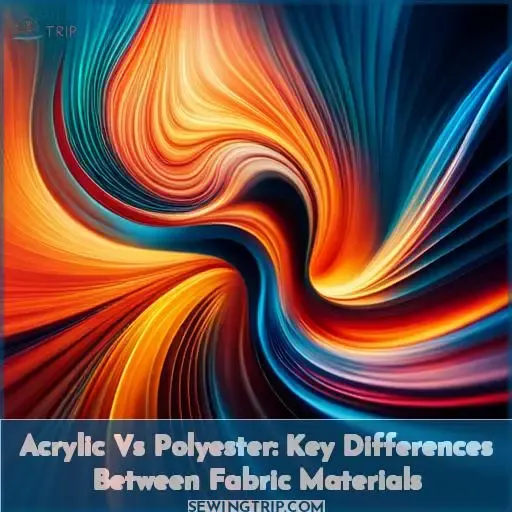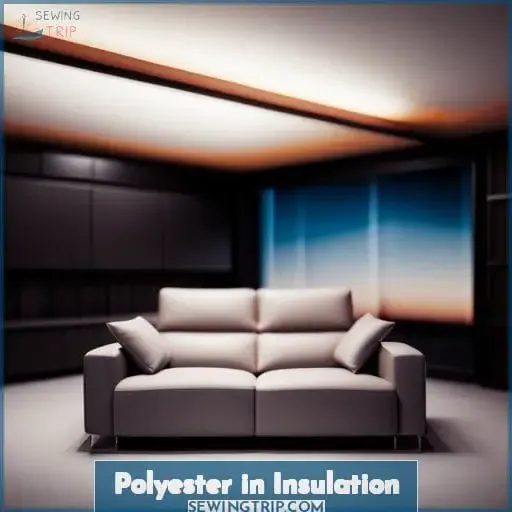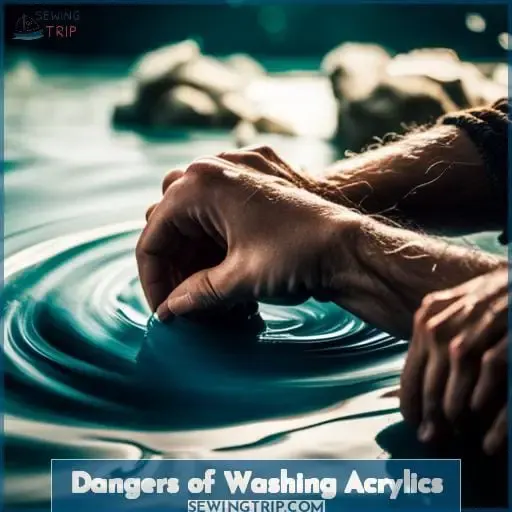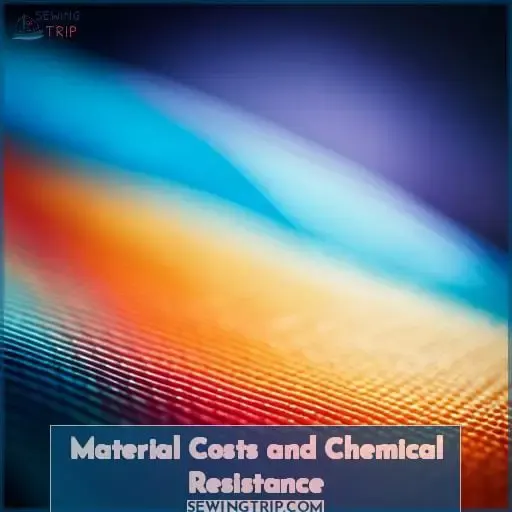This site is supported by our readers. We may earn a commission, at no cost to you, if you purchase through links.
 Mate, polyester, and acrylic might seem similar, but there are some key fabric differences.
Mate, polyester, and acrylic might seem similar, but there are some key fabric differences.
Polyester’s slick, moisture-wicking thread makes it perfect for athletic gear that hugs your body.
Meanwhile, acrylic’s fuzzier strands trap air for warmth, ideal when you need insulation from the cold.
Each has strengths; combining them gives you the best of both worlds.
Whether you’re climbing a mountain or lounging on the couch, understanding these fabrics helps you pick the right clothes.
Table Of Contents
- Key Takeaways
- Polyester Basics
- Acrylic Basics
- Polyester in Insulation
- Polyester Jackets: Softshells Vs. Hardshells
- Acrylic in Insulation
- Environmental Impact
- Dangers of Washing Acrylics
- Material Costs and Chemical Resistance
- Durability and Fabrication
- Creep and Dental Applications
- Frequently Asked Questions (FAQs)
- Conclusion
Key Takeaways
- Polyester is more versatile for performance apparel and outdoor gear given its breathability, moisture-wicking properties, and weather resistance.
- Polyester makes excellent insulating fabrics that retain warmth even when wet, thanks to innovations like those seen in Patagonia’s Nano Puff jacket.
- Both softshell and hardshell jackets utilize polyester, with softshells focused on lightweight warmth and breathability and hardshells providing weather-resistant exteriors.
- While acrylic provides unmatched warmth for the price point, its lack of breathability and sustainability issues point to the need for alternative insulation materials.
Polyester Basics
Polyester’s hydrophobic properties and low water absorption make it an excellent moisture-wicking fabric for your activewear.
The synthetic fibers actively pull moisture away from your skin, keeping you cool and dry during workouts.
Polyester is often blended with natural fibers like cotton or wool to create a tougher, more durable, and abrasion-resistant fabric.
Manufacturers can also enhance polyester’s inherent breathability during the production process.
Additional coatings and treatments can make polyester fabrics water-repellent yet breathable at the same time.
The blend of properties makes polyester a top choice for performance apparel and outdoor gear, especially when insulation and breathability are needed.
Polyester is commonly used to create the synthetic insulation inside jackets, sleeping bags, and even home furnishings.
Acrylic Basics
Frequently, you’ll find that acrylic is a strong and warm synthetic fiber with excellent heat-retention properties but horrible breathability, making it great for insulation.
As a textile engineer, I often recommend acrylic for its strength and warmth. The fibers have an incredible ability to trap heat, keeping you cozy on frigid days.
However, acrylic isn’t very breathable. It tends to hold onto moisture, causing you to feel clammy. This downside makes acrylic a wonderful insulating material for things like winter accessories and linings, where breathability isn’t as important.
Acrylic also resists UV rays, but has a tendency to pill.
Overall, acrylic’s strengths lie in insulation applications, while its poor breathability remains a concern.
Polyester in Insulation
From those acrylic basics, let’s dive into how polyester works in insulation.
You’ll often find recycled polyester providing excellent insulating properties without the bulk. Its hydrophobic nature and breathable properties allow it to provide warmth in wet weather, outperforming down.
Patagonia’s Nano Puff jacket exemplifies this through its use of Primaloft’s improved recycled polyester insulation.
Synthetic insulations like these allow clothing to provide warmth and resist precipitation without excessive bulk.
Polyester’s heat retention abilities and performance when wet make it a top choice over acrylic for insulating fabrics.
You can stay warm and comfortable thanks to polyester’s insulating capabilities.
Polyester Jackets: Softshells Vs. Hardshells
You’ll find polyester used both as a rugged outer shell and a warm inner lining when comparing softshell and hardshell jackets.
Softshell jackets provide lightweight warmth and breathability with their polyester fleece linings, making them perfect for active pursuits like hiking and climbing where you need insulation without bulk.
Hardshell jackets use durable, weather-resistant polyester or polyester blends to create a thin, lightweight outer shell that sheds rain and wind while allowing some breathability.
However, the thin polyester shell can lead to challenges with breathability and moisture control during high output activities.
Ultimately, both softshell and hardshell jackets utilize polyester’s versatility to find the right balance of warmth, weather resistance, and style for different needs.
Acrylic in Insulation
Now, let’s delve into the use of acrylic in insulation, building upon our previous discussion.
Acrylic delivers unparalleled warmth, but its poor breathability limits its efficacy in certain applications.
Insulation innovations like Primaloft’s recycled polyester provide performance rivaling down, sans the bulk.
Still, acrylic’s affordability and vibrant color retention make it ideal for fuzzy boot linings and playful faux fur trims.
Yet, acrylic sheds microplastics when washed, demanding more sustainable synthetic alternatives.
By coupling environmental solutions with acrylic’s strength, warmth, and style, we can responsibly harness this fiber’s potential while safeguarding our planet.
With proper care and responsible manufacturing, acrylic can retain its dimensional stability, vibrancy, and warming capabilities for generations to come.
Environmental Impact
When considering the environmental impact of acrylic and polyester fabrics, it’s crucial to note that both materials:
- Shed harmful microplastics when washed.
- Contribute to climate change through greenhouse gas emissions during production, as they are petroleum-based synthetics.
- Persist in the environment for hundreds of years because they aren’t biodegradable.
Microplastics
Your washing of acrylics contributes microplastic pollution to the world’s waterways.
Non-biodegradable polyester and acrylic fibers release microplastics into oceans when washed, harming sea life that ingest them.
Choosing natural, sustainable fabrics like cotton and wool reduces the microplastic impact on fish, birds, and other aquatic species.
We must consider the environmental consequences of synthetic fibers and strive for fabric sustainability.
Not Biodegradable
Having shed microplastics when washed, acrylic fibers contribute to environmental harm by not biodegrading and accumulating in natural habitats.
These petroleum-based synthetics stubbornly persist, cluttering landfills and choking waterways for centuries.
Sustainable natural fabrics like organic cotton biodegrade harmlessly, emphasizing eco-friendly disposal and reducing long-term pollution.
By choosing responsibly produced fibers, consumers mitigate acrylic’s non-biodegradable impact.
Greenhouse Gases
Production of acrylic and polyester releases harmful chemicals into the air, contributing to climate change.
They’re petrochemical-based fibers that release greenhouse gases like methane and CO2.
These greenhouse gases accelerate climate change and global warming.
Production requires significant energy input and fossil fuels, increasing emissions.
Consider more sustainable natural fibers like wool, cotton, hemp, and linen.
Support brands using recycled synthetics to reduce environmental impact.
Dangers of Washing Acrylics
When washing acrylic fabrics, you’re releasing microplastics into the water, contaminating water sources and harming aquatic life.
These synthetic fibers shed tiny plastic particles that marine animals mistake for food.
The toxic chemicals released damage ecosystems, accumulate in fish, and cause skin irritation and other health issues if absorbed through drinking water.
Finding sustainable alternatives is key.
Look for natural fiber clothing and wash synthetic items less frequently in bags to capture shedding.
We all have a role to play in reducing microplastic pollution and protecting water quality for the health of people and animals.
Even small changes help our planet.
Material Costs and Chemical Resistance
Polyester’s lower cost comes with increased chemical resistance to solvents and ketones compared to acrylic’s higher cost and susceptibility to damage.
Polyester has greater resistance to solvents like acetone and methyl ethyl ketone, allowing it to better withstand exposure during fabrication processes.
Acrylic is more prone to cracking and stress fractures when exposed to these chemicals.
The enhanced durability and chemical resistance of polyester makes it the more economical choice despite acrylic’s lower initial material expenses. Savings from reduced repairs and replacements offset higher production costs over time.
Ultimately, polyester’s superior chemical resilience justifies slightly elevated pricing, while acrylic’s vulnerability to solvents and ketones renders it less cost effective long term. Careful consideration of lifecycle expenses and fabrication challenges can inform selection between these materials.
Durability and Fabrication
With polyester’s increased brittleness, you’re dealing with greater chances of breakage and more airborne dust when sanding it, requiring extra care from you during fabrication and handling.
As a textile engineer, I prefer acrylic’s superior durability and ease of repairing cracks and defects. Acrylic produces less hazardous airborne particulate when shaping it, making my job safer. The acrylic’s chemical bonding for seaming also reduces human error compared to polyester’s mechanical seaming.
While polyester offers greater depth and color options thanks to thermoforming, acrylic enables tight bend radii in exchange for less depth and limited colors.
Ultimately when selecting a material, weigh the fabrication challenges like potential breakage and airborne hazards against your product requirements for depth, colors, and seaming. An informed decision balances your safety, process capability, and end-use goals.
Creep and Dental Applications
Moving on to creep and dental applications, let’s delve into the nuances of these materials.
Polyester’s reduced creep, or deformation over time, makes it the preferred choice for dental applications.
Its resistance to eugenol, a common component in dental materials, ensures its integrity and longevity.
On the other hand, acrylic exhibits higher creep, making it less suitable for certain dental applications.
However, its chemical bond for seaming reduces human error during fabrication, offering unique advantages in specific scenarios.
Understanding these creep factors is essential for selecting the appropriate material for various applications, whether it’s crafting durable dental prosthetics or ensuring the longevity of your favorite garments.
Frequently Asked Questions (FAQs)
How do acrylic and polyester fabrics compare in terms of warmth and breathability?
When comparing acrylic and polyester for warmth and breathability in apparel:
- Acrylic excels in heat retention but lacks airflow.
- Polyester provides some insulation while remaining more breathable.
The choice depends on your priorities:
- Pure warmth favors acrylic.
- Most situations benefit from polyester’s better breathability.
Which fiber is better for activewear that wicks moisture – acrylic or polyester?
For moisture-wicking activewear, polyester’s your pick.
Its hydrophobic nature keeps you dry, while acrylic’s breathability struggles to keep up.
Choose wisely, stay comfortable, stay active.
What are some advantages and disadvantages of acrylic versus polyester for home furnishings like blankets and upholstery?
When selecting fabrics for home furnishings, consider:
- Acrylic’s warmth, softness, and affordability.
- Polyester’s superior strength, durability, stain-resistance, and sustainability.
Evaluate your priorities:
- Acrylic excels in comfort.
- Polyester prevails in performance.
Thoughtfully weigh these tradeoffs as both offer advantages depending on your needs.
How do the dyeing processes and colorfastness compare between acrylic and polyester fabrics?
When comparing acrylic and polyester fabrics:
- Acrylic accepts dye more readily and achieves brighter, more vivid colors.
- Polyester is more colorfast, as its dye bonds more tenaciously to the synthetic fibers.
- Polyester holds its color better over time and with washing, while acrylic fades faster.
Are there any health or environmental concerns related specifically to wearing acrylic or polyester clothing next to skin?
Consider natural fibers instead.
Synthetics may irritate skin over time or shed microplastics into water during washing.
It is best to evaluate environmental impact and personal comfort when selecting fabrics.
Conclusion
As raindrops bead upon a waxed coat,
acrylic and polyester demonstrate complementary strengths.
While neither perfect nor environmentally benign,
their combined attributes enable functional, affordable garments meeting diverse needs.
Choosing thoughtfully between acrylic vs polyester
empowers us to dress appropriately for each occasion.
















